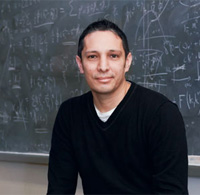Abstract: An electromagnetic metamaterial is an engineered composite in which subwavelength features, rather than the chemical makeup of the constituent materials, control the electromagnetic response. Electromagnetic metamaterials have experienced enormous excitement and growth recently due to the demonstration of exotic effects such as invisibility cloaking, negative refractive index, and perfect focusing. In fact metamaterials offer an electromagnetic response which has been shown to be impossible to achieve in naturally occurring materials. Additionally metamaterials are geometrically scalable meaning they may be tuned to operate in nearly any sub-optical wavelength band. We present theory, simulation, and experimental results of metamaterials operating at terahertz frequencies. Planar electric split ring resonator (eSRR) metamaterials and their corresponding inverse structures are designed and characterized computationally and experimentally utilizing finite element modeling and THz time domain spectroscopy. Complementary 'plasmonic' response is observed in transmission. The frequency dependent effective complex dielectric functions are extracted from the experimental data and, in combination with simulations to determine the surface current density and local electric field, provide considerable insight into the electromagnetic response of our planar metamaterials. Specifically, the metamaterial resonances observed in the dielectric function for each structure occur at the peak of the loss function of the complimentary metamaterial. Specific emphasis is placed on the demonstration of external control of planar arrays of metamaterials patterned on semiconducting substrates with terahertz time domain spectroscopy used to characterize device performance. These structures may find applications for the construction of needed components operating within the technologically relevant THz frequency regime.
Biography: Willie received both MS and PhD degrees in Physics from UC San Diego. His PhD thesis work, completed in 2004, was for investigation of the THz, infrared, optical and magneto-optic properties of novel materials utilizing various spectroscopic methods, including Fourier transform spectroscopy and ellipsometry. Materials studied include high temperature superconductors, pyrochlores, and artificial metamaterials. Willie is an author on the “discovery” paper on "left-handed" or Negative Index (NI) materials, and the main contributor to demonstrating artificial magnetic response at THz frequencies. Willie was a Los Alamos Director’s postdoctoral fellow working in the laboratory for ultrafast optics in MST-CINT. His postdoctoral work at Los Alamos focused on terahertz time domain spectroscopy of novel materials. He is currently an Assistant Professor of Physics at Boston College. Willie’s research interests are primarily directed towards simulating, fabricating and measuring metamaterials at THz frequencies and the characterization of high temperature superconductors. He is an expert in infrared, terahertz time domain, and magneto-optical spectroscopy.


